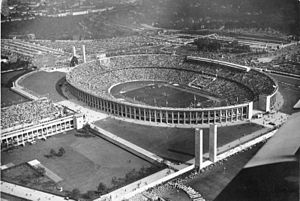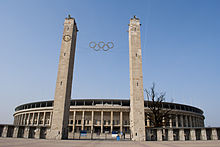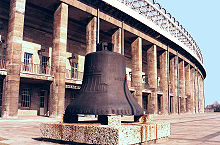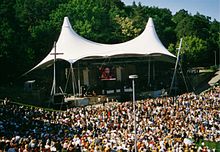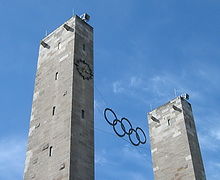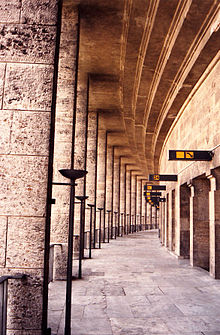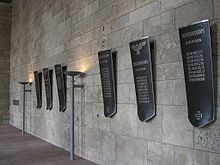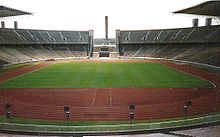- Olympic Stadium (Berlin)
-
"Olympiastadion" redirects here. For the stadium in Munich, see Olympic Stadium (Munich). For other uses, see Olympic Stadium.
Olympiastadion 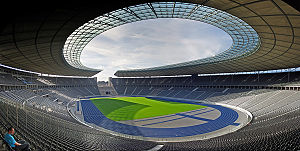
Full name Berlin Olympiastadion Former names Deutsches Stadion Location Berlin, Germany Coordinates 52°30′53″N 13°14′22″E / 52.51472°N 13.23944°ECoordinates: 52°30′53″N 13°14′22″E / 52.51472°N 13.23944°E Built 1934 to 1936 Opened 1936 Renovated 1974 (Reconfiguration)
2006 (World Cup)Owner Olympiastadion Berlin GmbH Operator WALTER BAU-AG/DYWIDAG Surface Grass Construction cost 43 million RM (1936)
€247 million (2004)Architect Werner March/ Albert Speer (1936)
Friedrich Wilhelm Krahe (1974)Capacity 74,500 (seated) Field dimensions 105 x 68 m Tenants
Hertha BSC (Bundesliga) (1963–present)
1936 Summer Olympics
FIFA World Cup (1974, 2006)
Berlin Thunder (NFL Europa) (2004–2007)
2009 World Championships in Athletics, 2011 FIFA Women's World CupThe Olympiastadion (Olympic Stadium) is a sports stadium in Berlin, Germany. There have been two stadiums on the site: the present facility, and one that is called the Deutsches Stadion which was built for the aborted 1916 Summer Olympics. Both were designed by members of the same family, the first by Otto March and the second by his son Werner March. It is the home stadium of the Hertha Berlin football team playing in the German Bundesliga.
The current Olympiastadion was originally built for the 1936 Summer Olympics in the southern part of the Reichssportfeld (today Olympiapark Berlin). During World War II, the area suffered little damage. After the war, the British military occupation used the northern part of the Reichssportfeld as its headquarters until 1994. From 1951 to 2005, the Olympischer Platz had a giant antenna transmitting for all the portable radios in Berlin.
Aside from its use as an Olympic stadium, the Olympiastadion has a strong footballing tradition. Historically, it is the ground of club Hertha BSC since 1963. It was also used for 3 matches in the 1974 FIFA World Cup. It hosted six matches, including the final, in the 2006 FIFA World Cup and was renovated for that reason. The German Cup final match is held each year at the Olympiastadion. The stadium sees use in other sports as well; at one point it held the world record for the attendance of a baseball game, thought to be over 110,000.
History
1916 to 1934: Deutsches Stadion, old Olympiastadion
During the 1912 Summer Olympics, the city of Berlin was designated by the International Olympic Committee (IOC) to host the 1916 Summer Olympics. Germany's proposed stadium for this event was to be located in Charlottenburg, in the Grunewald Forest, to the west of Berlin—thus the stadium was also known as Grunewaldstadion. A horse racing-course already existed there which belonged to the Berliner Rennverein, and even today the old ticket booths survive on Jesse-Owens-Allee. The government of Germany decided not to build in the nearby Grunewald forest, or to renovate buildings that already existed. Because of this desire, they hired the same architect who originally had built the "Rennverein", Otto March.
March decided to bury the stadium in the ground ("Erdstadion", in German).
However, the 1916 Olympic Games were cancelled due to World War I. After this conflict, a school was founded in the vicinity of the Stadium, dedicated to the teaching of professors of physical education and the study of sport science. From 1926 to 1929, Otto March's sons (Werner and Walter) were assigned to build an annex for these institutions: the "Deutsches Sportforum" (German Sportforum), though the construction was intermittent because the project had little financial support.
1936: Reichssportfeld
In 1931, the International Olympic Committee made Berlin the host city of the 11th Summer Olympics.
Originally, the German government decided merely to restore the earlier Olympiastadion (German Stadium) of 1916, with Werner March again retained to do this.
When the Nazis came to power in Germany (1933), they decided to use the Olympic Games for propaganda purposes. With these plans in mind, Hitler ordered the construction of a great sports complex in Grunewald named the "Reichssportfeld" with a totally new Olympiastadion. Architect Werner March remained in charge of the project, assisted by his brother Walter March.
Construction took place from 1934 to 1936. When the Reichssportfeld was finished, it was 1.32 square kilometres (326 acres). It consisted of (east to west): the Olympiastadion, the Maifeld (Mayfield, capacity of 50,000) and the Waldbühne amphitheater (capacity of 25,000), in addition to various places, buildings and facilities for different sports (such as football/soccer, swimming, equestrian events, and field hockey) in the northern part.
Olympiastadion
Werner March built the new Olympiastadion on the foundation of the original Deutsches Stadion, once again with the lower half of the structure buried 12 meters underground.
The capacity of the Olympiastadion reached 110,000 spectators. It also possessed a special stand for Adolf Hitler and his political associates. At its end, aligned with the symmetrically-designed layout of the buildings of the Olympischer Platz and toward the Maifeld, was the Marathon Gate with a big receptacle for the Olympic Flame.
To the east of the stadium, there were two field hockey stadiums that hosted the competitions that were won by India.
Maifeld
Maifeld (Mayfield) was created as a huge lawn (112,000 square metres, 28 acres) for gymnastic demonstrations, specifically annual May Day celebrations by Hitler's government.
Maifeld was surrounded by 19 metres of land elevation (62 ft), even though the Olympiastadion (to the east) was only 17 metres (55 ft) high.
The total capacity was 250,000 people, with 60,000 in the large stands that extended at the west end. Also located there were the Langemarck-Halle (below) and the Bell Tower (rising high).
The walls were built with sturdy stone from the area of the Lower Alps, and also feature equine sculptures (work of Josef Wackerle).
During the 1936 Olympics, the Maifeld was used for polo and equestrian dressage events.
Bell Tower
The Bell Tower crowned the western end of the Reichs Sportfield planted amid the tiers of the Maifeld stands. It was 77 metres (247 ft) high. From its peak could be observed the whole city of Berlin. During the games, it was used as observation post by administrators and police officials, doctors and the media.
In the tower was the Olympic Bell. On its surface were the Olympic Rings with an eagle, the year 1936, the Brandenburg Gate, the date 1.-16. August and a motto between two swastikas: I call the youth of the world[1] and 11. Olympic Games Berlin – although the games was 10th (Summer) Olympics, but the Games of the XI Olympiad.
The Bell Tower was the only part of the Reichssportfeld that was destroyed in the war. The Third Reich used tower's structure to store archives (such as films). The Soviet troops set its contents on fire, turning the tower into a makeshift chimney. The structure emerged from the fire severely damaged and weakened.
In 1947, the British engineers demolished the tower, however reconstructed it faithfully in 1962. The Olympic Bell (which had survived the fire and remained in its place in the tower) fell 77 metres and cracked and has been unable to sound since then. In 1956, the bell was rescued, only in order to be used as a practice target for shooting with anti-tank ammunition. The old bell survives to this day and serves now as a memorial.
The restoration of the tower was carried out from 1960 to 1962, once again by the architect Werner March, following the original blueprints. The present tower became an important tourist destination offering a panorama of Berlin, Spandau, the Havel Valley, Potsdam, Nauen and Hennigsdorf.
The Langemarck-Halle
This consisted of huge halls built under the stands of the Maifeld. Pillars were raised on which hung flags and shields commemorating all the forces that participated in a battle fought in Langemark (West Flanders, Belgium) on November 10, 1914, during the First World War. Since 2006, the ground floor is home to a public exhibit providing historical information on the area of the former Reichssportfeld.
Waldbühne, the Forest Theatre
The Waldbühne was built by using the glacial river banks of the Berlin glacial valley. It is a reproduction of the old theater of Epidaurus (3rd century BC). The theater was then named "Dietrich-Eckart-Bühne" in homage to Dietrich Eckart.[citation needed]
Seating for up to 23,000 spectators goes down to a depth of 30 metres (97 ft); in the middle section Adolf Hitler's box once stood.[citation needed] The surroundings were decorated with statues by Adolf Wamper. During the Olympics, gymnastics competitions and a myriad of cultural programs were staged in the Waldbühne.
Today, it is used as one of Europe's biggest concert venues. The Berlin Philharmonic has staged the Waldbühne concert in June every year since 1984. Since 2009, its operator has been CTS Eventim.
Berlin, 1936 Summer Olympics
On August 1, 1936, the Olympics were officially inaugurated by the head of state Adolf Hitler, and the Olympic Flame was lit by the athlete Fritz Schilgen.
While the Olympic Flame had been used for the first time in Amsterdam 1928, in Berlin 1936 a marathon-like tour of the Olympic Torch was introduced, from Olympia in Greece, crossing six frontiers with a journey of 3000 km to Berlin, through Greece, Bulgaria, Yugoslavia, Hungary, Czechoslovakia, Austria and Germany. The original idea of this Olympic torch relay was Carl Diem's, who was a notorious political advisor to Nazi Propaganda Minister Joseph Goebbels, specialising in Olympic affairs.
Four million tickets were sold for all the events of the 1936 Summer Olympics. This was also the first Olympics with television transmission (25 giant screens were scattered all over Berlin) and radio transmissions in 28 languages (with 20 radio vans and 300 microphones).
Among the sport competitions, one of the most memorable events was the performance of the African-American track and field athlete Jesse Owens, representing the United States of America. Owens won the gold medal in the 100, 200, long jump and 4 x 100 relay.
During those games, they also hosted the equestrian jumping, football, and handball events.
The 1936 Olympics held in the stadium were immortalised in the film Olympia (1938) by Leni Riefenstahl.
1939 to 1945: World War II
The Olympiastadion was one of the few buildings that survived not just in a recognizable form, but almost untouched after the Second World War. It only suffered the impact of machine gun shots.
The most significant battle around the Olympiastadion was in April 1945 when the Soviet army fought to capture it. This was during the great final battle of the Second World War in Europe, with the total invasion of Berlin as the Allies' target.
1945 to 1994: Occupied Berlin
After the war, the former Reichssportfeld was used as headquarters of the British military occupation forces.
The British forces settled in the northern buildings designed by the March brothers in the 1920s, which the Third Reich had used for official sport organisations such as the Reich Academy of Physical Training and the House of German Sports. Soon, the Occupation started a careful reconstruction of the general facilities. From then until 1994, British forces held an annual celebration of The Queen's Official Birthday in the Maifeld with thousands of spectators from Berlin present. During the 1960s, American military and high school football teams introduced hundreds of thousands of Berliners to American football at the stadium in exhibition games.
During those years, Bundesliga (football) matches were played in the Olympiastadion, with Hertha BSC as local team. In the Maifeld, several competitions of football, rugby and polo were staged too. In the summers, the Waldbühne resumed its classical music concerts, and playing movies. The theatre was also used as an improvised ring for boxing matches.
Hertha BSC
In 1963, the Bundesliga was formed, and Hertha BSC participated by direct invitation, leaving its old stadium (the "Plumpe") to use the Olympiastadion. On August 24, it played the first local match against FC Nuremberg, with the final score 1:1. However, in 1965, the German Football Association found Hertha BSC guilty of bribery and relegated them to the Regional Leagues. Hertha had illegally bribed several football players in an attempt to add them to the team, following their disinterest in playing in Berlin because of the construction of the Berlin Wall (1961). In 1968, Hertha returned to the first division, and to the Olympiastadion, and in 1971 sold "Plumpe". The second half of 1970s was quite successful for Hertha BSC Berlin. In 1979, it reached the semifinals of the UEFA Cup, but was defeated by Red Star Belgrade. Hertha reached the finals of the German Cup twice (1977 and 1979).
In the 1980s, Hertha had a declining role in the Bundesliga, and fell to the Regional Leagues in 1986, although they later recovered reaching the Second Division (1988–1989).
With the demolition of the Berlin Wall in November 1989, a spontaneous feeling of sympathy between Hertha and FC Union from Eastern Berlin arose, which culminated in a friendly match at the Olympiastadion with 50,000 spectators (January 27, 1990).
In 1990, Hertha returned to the First Division, although it fell again to the Second Division from 1991 until 1997.
Since 1997, the club has improved greatly, climbing up the Bundesliga table and qualifying for the UEFA Champions League, with matches against top European teams like Chelsea and A.C. Milan, increasing the international prestige of the club.
1974 FIFA World Cup
Some matches of Group A (West Germany, Chile, East Germany and Australia) of the 1974 FIFA World Cup were played in the Olympiastadion. The third match, Australia vs Chile, was played in torrential rain. The hosts, West Germany, won the tournament.
FIFA Day Match Round Team 1 Team 2 Destination June 14 Group A  West Germany 1
West Germany 1Vs.  Chile 0
Chile 0Second Round June 18 Group A  East Germany 1
East Germany 1Vs.  Chile 1
Chile 1Second Round June 22 Group A  Australia 0
Australia 0Vs.  Chile 0
Chile 0Second Round Team Pts Pld W D L GF GA GD  East Germany
East Germany5 3 2 1 0 4 1 3  West Germany
West Germany4 3 2 0 1 4 1 3  Chile
Chile2 3 0 2 1 1 2 −1  Australia
Australia1 3 0 1 2 0 5 −5 1994 to 2005
In 1998, Berliners debated the destiny of the Olympiastadion in light of the legacy it represented for Germany.
Some wanted to tear the stadium down and build a new one from scratch, while others favoured letting it slowly crumble "like the Colosseum in Rome".[2]
Finally, it was decided to renovate the Olympiastadion. FIFA then chose it as one of the venues of the 2006 FIFA World Cup. The State of Berlin hired a consortium composed of Walter Bau AG and DYWIDAG that won the €45 million franchise. The consortium took charge of the operation of the facilities together with Hertha BSC and the Government of Berlin after the remodelling.
On July 3, 2000, the renovation began with a ceremony presided over by the Chancellor Gerhard Schröder, accompanied by Eberhard Diepgen (Berlin Mayor), Franz Beckenbauer and Prof. Dr. Ignaz Walter.
The Reconstruction
70,000 cubic metres (92,000 yd3) of concrete and 20,000 cubic metres (26,000 yd3) of pre-cast reinforced concrete elements were used. 12,000 cubic metres (16,000 yd3) of concrete was demolished and removed and 30,000 cubic metres (39,000 yd3) of natural stone was refurbished.
The roof was extended to cover a total of 37,000 square metres, with 20 roof-supporting columns carrying a weight of 3,500 tonnes of steel.
With the intention of creating a more intimate atmosphere for football games, the playing field was lowered (even more) by 2.65 metres (8.7 ft); approximately 90,000 cubic metres (120,000 yd3) of sand was excavated. The lower tier of seating in the stadium was demolished and rebuilt at a completely different angle of inclination.
The conservation factor of the Olympiastadion as a historical monument was also considered, especially with respect to the preservation of the natural stone blocks. After criticisms, the colour of the athletics track around the game field was changed from red to blue, reflecting the colours of Hertha BSC.
On January 9, 2002, construction workers found an unexploded World War II bomb buried beneath a section of seating. It was defused outside the stadium by Berlin police.[3]
Technical details
The new Olympic Stadium has the highest all-seated capacity in Germany at 74,500. The only stadium to have more total capacity is Dortmund's Signal Iduna Park (formerly Westfalenstadion) (though the Westfalenstadion has both seating and standing areas, and its all seated capacity of 65,718 is lower than the Olympiastadion).
The roof rises 68 metres over the seats and is made up of transparent panels that allow sunlight to stream in during the day. The western portion (on the Marathon Arch) is open to reveal the Bell Tower to the spectators.
The Olympiastadion was equipped with the latest technology in artificial illumination and sound equipment. It has 113 VIP stands, a set of restaurants, and two underground garages (for 630 cars).
The total cost of the remodelling and amplification was €242 million.
Reinauguration and post-reinauguration
The reinauguration celebrations of the new Olympic Stadium were carried out on July 31, 2004 and August 1, 2004. On that day, Saturday, the party began with performances from P!nk, Nena and Daniel Barenboim. It culminated at night with the opening ceremony.
On day two, friendly matches were played between different categories of the club Hertha BSC and visiting teams. On September 8, 2004, Brazil played Germany.
British electronic legends Depeche Mode performed during their Tour Of The Universe on June 10, 2009 in front of 68,000 people. The show was recorded by Live Here Now for the live albums project Recording the Universe.
Current tenants
The stadium is currently used as the home venue for the Fußball-Bundesliga's Hertha BSC. Since 1985, the stadium has hosted the finals of both the DFB-Pokal and its companion women's tournament, the Frauen DFB Pokal. However, it will not host the 2010 final of the Frauen DFB Pokal, which will be held at Cologne's RheinEnergieStadion as part of an experimental test to host the event in a different city. The stadium also hosts the Internationales Stadionfest, which also served as an IAAF Golden League event until 2010, it is currently unknown if it will be apart of the new IAAF Diamond League.
The stadium also served as home to the Berlin Thunder, an American football team in NFL Europa, until the league's operator, the U.S. National Football League, closed down the money-losing competition in 2007.
The stadium was a possible venue for the 2011 UEFA Champions League Final, along with the Allianz Arena in Munich before Wembley Stadium in London was decided as the venue in January 2009.
FIFA World Cup 2006
This was the location of the World Cup final between France and Italy and the site of Zinedine Zidane's infamous headbutt.
Scheduled matches
Date Time (CEST) Team #1 Result Team #2 Round Spectators 13 June 2006 21.00  Brazil
Brazil1 – 0  Croatia
CroatiaGroup F 72,000 15 June 2006 21.00  Sweden
Sweden1 – 0  Paraguay
ParaguayGroup B 72,000 20 June 2006 16.00  Germany
Germany3 – 0  Ecuador
EcuadorGroup A 72,000 23 June 2006 16.00  Ukraine
Ukraine1 – 0  Tunisia
TunisiaGroup H 72,000 30 June 2006 17.00  Germany
Germany1 – 1 (4 – 2 PEN)  Argentina
ArgentinaQuarter-finals 72,000 9 July 2006 20.00  Italy
Italy1 – 1 (5 – 3 PEN)  France
FranceFinal 72,000 Political considerations
The Olympiastadion was designated to play the final match of the 2006 FIFA World Cup. This took place exactly 70 years after the 1936 Summer Olympics.
Peter Steinhorst, chief technician on the project, said to the BBC: "Whenever you enter, you will still know this was the site of the 1936 Games. You will pass all the old Nazi sculptures".[2]
"The history is there, the totality of the buildings is there. The whole Nazi landscape has not disappeared", added the sports sociologist Günther Gebauer. "There are towers like in a fortress, and people who come will always ask where the Führer sat.".[2]
Germany's Interior Minister Otto Schily, who attended the opening party, concluded: "The stadium recalls the dark elements present in its creation. But in 2006 the world will look upon to modern, democratic, and open Germany".[2]
Literature
Audiobook
"Olympic Stadium Berlin" by Andreas Janowski. Published by Andreas Janowski Verlag under the label "sights-on-audio" www.sights-on-audio.com
References
- ^ Olympic Games Berlin 1936 – The emblem International Olympic Committee
- ^ a b c d "New future for Nazi stadium". BBC. 31 July 2004. http://news.bbc.co.uk/2/hi/europe/3942661.stm. Retrieved 2008-08-27.
- ^ "WW II bomb in Berlin stadium". BBC. 9 January 2002. pp. 1. http://news.bbc.co.uk/1/hi/world/europe/1750110.stm. Retrieved 2008-08-27.
- 1936 Summer Olympics official report. Volume 1. pp. 141–9, 154–62.
External links
- Official Olympiastadion Site
- Picture galleries: An illustrative walk along the facilities of the Olympischer Platz.
- Hertha BSC official website
- Olympiastadion at Footballmatch
Preceded by
Yokohama Stadium
YokohamaFIFA World Cup
Final Venue
2006Succeeded by
Soccer City
JohannesburgHertha BSC Information Club · Managers · Players · Reserve Team · StadiumSeasons 1980–81 · 2006-07 · 2007–08 · 2008–09 · 2009–10 · 2010–11 · 2011–12Bundesliga venues (2011–12) Allianz Arena · AWD-Arena · BayArena · Borussia-Park · Coface Arena · Dreisamstadion · Frankenstadion · Fritz-Walter-Stadion · Mercedes-Benz Arena · Olympiastadion · RheinEnergieStadion · Rhein-Neckar-Arena · SGL arena · Veltins-Arena · Volksparkstadion · Volkswagen Arena · Weserstadion · Westfalenstadion1974 FIFA World Cup Stadiums Olympiastadion (West Berlin) · Westfalenstadion (Dortmund) · Rheinstadion (Düsseldorf) · Waldstadion (Frankfurt) · Parkstadion (Gelsenkirchen) · Volksparkstadion (Hamburg) · Niedersachsenstadion (Hanover) · Olympiastadion (Munich) · Neckarstadion (Stuttgart)2006 FIFA World Cup Stadiums FIFA WM-Stadion Dortmund (Dortmund) · FIFA WM-Stadion Frankfurt (Frankfurt) · FIFA WM-Stadion Gelsenkirchen (Gelsenkirchen) · FIFA WM-Stadion Hamburg (Hamburg) · FIFA WM-Stadion Hannover (Hanover) · FIFA WM-Stadion Köln (Cologne) · FIFA WM-Stadion München (Munich) · Frankenstadion (Nuremberg) · Fritz-Walter-Stadion (Kaiserslautern) · Gottlieb-Daimler-Stadion (Stuttgart) · Olympiastadion (Berlin) · Zentralstadion (Leipzig)2011 FIFA Women's World Cup stadia Borussia-Park (Mönchengladbach) · FIFA Frauen-WM-Stadion Augsburg (Augsburg) · FIFA Frauen-WM-Stadion Bochum (Bochum) · FIFA Frauen-WM-Stadion Frankfurt (Frankfurt) · FIFA Frauen-WM-Stadion Leverkusen (Leverkusen) · FIFA Frauen-WM-Stadion Wolfsburg (Wolfsburg) · Olympiastadion (Berlin) · Rhein-Neckar-Arena (Sinsheim) · Rudolf Harbig Stadion (Dresden)Summer Olympic stadia Athens 1896 • Paris 1900 • St Louis 1904 • London 1908 • Stockholm 1912 • Antwerp 1920 • Paris 1924 • Amsterdam 1928 • Los Angeles 1932 • Berlin 1936 • London 1948 • Helsinki 1952 • Melbourne 1956 • Rome 1960 • Tokyo 1964 • México City 1968 • Munich 1972 • Montréal 1976 • Moscow 1980 • Los Angeles 1984 • Seoul 1988 • Barcelona 1992 • Atlanta 1996 • Sydney 2000 • Athens 2004 • Beijing 2008 • London 2012 • Rio de Janeiro 2016Venues of the 1936 Summer Olympics Avus Motor Road · BSV 92 Field & Stadium · Dietrich Eckert Open-Air Theatre · Döberitz · Deutschlandhalle · Grünau Regatta Course · Haus des Deutschen Sports · Hertha-BSC Field · Hockey Stadion · Hockey Stadion #2 · Kiel Bay · Mayfield · Mommsenstadion · Olympic Stadium · Olympic Swimming Stadium · Police Stadium · Poststadion · Ruhleben · Tennis Courts · Tennis Stadium · Wannsee Golf Course · Wannsee Shooting Range1900: 7th arrondissement of Paris • 1912: Fältrittklubben, Liljeholmen, Lindarängen, Östermalm Athletic Grounds, Stockholm Olympic Stadium • 1920: Olympisch Stadion • 1924: Hippodrome d'Auteuil, Stade de Colombes • 1928: Hilversum, Olympic Stadium • 1932: Olympic Stadium, Riviera Country Club, Westchester • 1936: Döberitz, Mayfield, Olympic Stadium • 1948: Aldershot, Empire Stadium, Tweseldown Racecourse • 1952: Laakso, Olympic Stadium, Ruskeasuo Equestrian Hall, Tali Race Track • 1956: Lill-Jansskogen, Olympic Stadium, Ulriksdal • 1960: Piazza di Siena, Pratoni del Vivaro • 1964: Karuizawa, National Stadium • 1968: Avándaro Golf Club, Campo Marte, Estadio Olímpico Universitario • 1972: Dressage Facility Nymphenburg, Olympiastadion, Riding Facility, Riem • 1976: Olympic Equestrian Centre, Bromont, Olympic Stadium • 1980: Grand Arena, Trade Unions' Equestrian Complex • 1984: Fairbanks Ranch Country Club, Santa Anita Park • 1988: Olympic Stadium, Seoul Equestrian Park • 1992: Club Hípic El Montayá, Real Club de Polo de Barcelona • 1996: Georgia International Horse Park • 2000: Sydney International Equestrian Centre • 2004: Markopoulo Olympic Equestrian Centre • 2008: Hong Kong Equestrian Venues • 2012: Greenwich Park • 2016: National Equestrian Center 1908: White City Stadium • 1920: Olympisch Stadion • 1928: Old Stadion • 1932: Olympic Stadium • 1936: Hockey Stadion (final), Hockey Stadion #2 • 1948: Empire Stadium (medal matches), Guinness Sports Club, Lyons' Sports Club, Polytechnic Sports Ground • 1952: Velodrome • 1956: Hockey Field, Melbourne Cricket Ground (final) • 1960: Campo Tre Fontane, Olympic Velodrome (final), Stadio dei Marmi • 1964: Komazawa Hockey Field • 1968: Municipal Stadium • 1972: Hockeyanlage • 1976: Molson Stadium, McGill University • 1980: Dynamo Central Stadium, Minor Arena; Young Pioneers Stadium (final) • 1984: Weingart Stadium • 1988: Seongnam Stadium • 1992: Estadi Olímpic de Terrassa • 1996: Clark Atlanta University Stadium, Morris Brown College Stadium (final) • 2000: State Hockey Centre • 2004: Olympic Hockey Centre • 2008: Olympic Green Hockey Field • 2012: Olympic Hockey Centre • 2016: Olympic Hockey Center
1908: White City Stadium • 1920: Olympisch Stadion • 1928: Old Stadion • 1932: Olympic Stadium • 1936: Hockey Stadion (final), Hockey Stadion #2 • 1948: Empire Stadium (medal matches), Guinness Sports Club, Lyons' Sports Club, Polytechnic Sports Ground • 1952: Velodrome • 1956: Hockey Field, Melbourne Cricket Ground (final) • 1960: Campo Tre Fontane, Olympic Velodrome (final), Stadio dei Marmi • 1964: Komazawa Hockey Field • 1968: Municipal Stadium • 1972: Hockeyanlage • 1976: Molson Stadium, McGill University • 1980: Dynamo Central Stadium, Minor Arena; Young Pioneers Stadium (final) • 1984: Weingart Stadium • 1988: Seongnam Stadium • 1992: Estadi Olímpic de Terrassa • 1996: Clark Atlanta University Stadium, Morris Brown College Stadium (final) • 2000: State Hockey Centre • 2004: Olympic Hockey Centre • 2008: Olympic Green Hockey Field • 2012: Olympic Hockey Centre • 2016: Olympic Hockey Center
List of Olympic venues in football 1900: Vélodrome de Vincennes · 1904: Francis Field · 1908: White City Stadium · 1912: Råsunda Stadium, Stockholm Olympic Stadium (final), Traneberg · 1920: Jules Ottenstadion, Olympisch Stadion (final), Stade Joseph Marien, Stadion Broodstraat · 1924: Stade Bergeyre, Stade de Colombes (final), Stade de Paris, Stade Pershing · 1928: Monnikenhuize, Olympic Stadium (final), Sparta Stadion Het Kasteel · 1936: Hertha-BSC Field, Mommsenstadion, Olympic Stadium (final), Poststadion · 1948: Arsenal Stadium, Champion Hill, Craven Cottage, Cricklefield Stadium, Empire Stadium (medal matches), Green Pond Road, Griffin Park, Selhurst Park, White Hart Lane · 1952: Helsinki Football Grounds, Kotka, Lahti, Olympic Stadium (final), Tampere, Turku · 1956: Melbourne Cricket Ground (final), Olympic Park Stadium · 1960: Florence Communal Stadium, Grosseto Communal Stadium, L'Aquila Communal Stadium, Livorno Ardenza Stadium, Naples Saint Paul's Stadium, Pescara Adriatic Stadium, Stadio Flaminio (final) · 1964: Komazawa Olympic Park Stadium, Mitsuzawa Football Field, Osaka Nagai Stadium, Tokyo National Stadium (final), Nishikyogoku Athletic Stadium, Ōmiya Football Field, Prince Chichiba Memorial Football Field · 1968: Estadio Azteca (final), Estadio Cuauhtémoc, Estadio Nou Camp, Jalisco Stadium · 1972: Drei Flüsse Stadion, ESV-Stadion, Jahnstadion, Olympiastadion (final), Rosenaustadion, Urban Stadium · 1976: Lansdowne Park, Olympic Stadium (final), Sherbrooke Stadium, Varsity Stadium · 1980: Dynama Stadium, Dynamo Central Stadium, Grand Arena, Grand Arena (final), Kirov Stadium, Republican Stadium · 1984: Harvard Stadium, Navy – Marine Corps Memorial Stadium, Rose Bowl (final), Stanford Stadium · 1988: Buson Stadium, Daegu Stadium, Daejeon Stadium, Dongdaemun Stadium, Olympic Stadium (final) · 1992: Estadi de la Nova Creu Alta, Estadi del FC Barcelona (final), Estadio Luís Casanova, La Romareda, RCD Espanyol Stadium · 1996: Florida Citrus Bowl, Legion Field, Orange Bowl, RFK Memorial Stadium, Sanford Stadium (final) · 2000: Brisbane Cricket Ground, Bruce Stadium, Hindmarsh Stadium, Melbourne Cricket Ground, Olympic Stadium (men's final), Sydney Football Stadium (women's final) · 2004: Kaftanzoglio Stadium, Karaiskakis Stadium, Olympic Stadium (final), Pampeloponnisiako Stadium, Pankritio Stadium, Panthessaliko Stadium · 2008: Beijing National Stadium (final), Qinhuangdao Olympic Sports Center Stadium, Shanghai Stadium, Shenyang Olympic Sports Center Stadium, Tianjin Olympic Center Stadium, Workers Stadium · 2012: City of Coventry Stadium, Hampden Park, Millennium Stadium, St James' Park, Wembley Stadium (final) · 2016: Brasília National Stadium, Fonte Nova, Maracanã (final), Mineirão, Morumbi 1896: Panathinaiko Stadium • 1900: Vélodrome de Vincennes • 1904: Francis Field • 1908: White City Stadium • 1912: Stockholm Olympic Stadium • 1920: Olympisch Stadion • 1924: Stade de Colombes • 1928: Olympic Stadium • 1932: Olympic Stadium • 1936: Dietrich Eckert Open-Air Theatre • 1948: Empress Hall, Earl's Court • 1952: Messuhalli • 1956: West Melbourne Stadium • 1960: Baths of Caracalla • 1964: Tokyo Metropolitan Gymnasium • 1968: National Auditorium • 1972: Olympiahalle • 1976: Montreal Forum • 1980: Sports Palace • 1984: Pauley Pavilion • 1988: Olympic Gymnastics Hall • 1992: Palau dels Esports de Barcelona, Palau Sant Jordi • 1996: Georgia Dome, University of Georgia Coliseum • 2000: Sydney SuperDome, The Dome and Exhibition Complex • 2004: Galatsi Olympic Hall, Olympic Indoor Hall • 2008: Beijing National Indoor Stadium, Beijing University of Technology Gymnasium • 2012: North Greenwich Arena, Wembley Arena • 2016: Rio Olympic Arena
1896: Panathinaiko Stadium • 1900: Vélodrome de Vincennes • 1904: Francis Field • 1908: White City Stadium • 1912: Stockholm Olympic Stadium • 1920: Olympisch Stadion • 1924: Stade de Colombes • 1928: Olympic Stadium • 1932: Olympic Stadium • 1936: Dietrich Eckert Open-Air Theatre • 1948: Empress Hall, Earl's Court • 1952: Messuhalli • 1956: West Melbourne Stadium • 1960: Baths of Caracalla • 1964: Tokyo Metropolitan Gymnasium • 1968: National Auditorium • 1972: Olympiahalle • 1976: Montreal Forum • 1980: Sports Palace • 1984: Pauley Pavilion • 1988: Olympic Gymnastics Hall • 1992: Palau dels Esports de Barcelona, Palau Sant Jordi • 1996: Georgia Dome, University of Georgia Coliseum • 2000: Sydney SuperDome, The Dome and Exhibition Complex • 2004: Galatsi Olympic Hall, Olympic Indoor Hall • 2008: Beijing National Indoor Stadium, Beijing University of Technology Gymnasium • 2012: North Greenwich Arena, Wembley Arena • 2016: Rio Olympic Arena 1936: BSV 92 Field & Stadium, Olympic Stadium (final), Police Stadium • 1972: Böblingen Sportshalle, Donauhalle Ulm, Hohenstaufenhalle Göppingen, Olympiahalle (final), Sporthalle Augsburg • 1976: Complexe sportif Claude-Robillard, Montreal Forum (final), Pavillion de l'éducation physique et des sports de l'Université Laval • 1980: Dynamo Palace of Sports, Sokolniki Sports Palace (final) • 1984: Titan Gymnasium • 1988: Suwon Gymnasium • 1992: Palau D'Esports de Granollers, Palau Sant Jordi (final) • 1996: Georgia Dome (men's final), Georgia World Congress Center • 2000: The Dome and Exhibition Complex • 2004: Faliro Sports Pavilion Arena, Helliniko Indoor Arena (final) • 2008: Beijing National Indoor Stadium (final), Olympic Sports Center Gymnasium • 2012: Basketball Arena (medal round), Handball Arena • 2016: Olympic Training Center – Arena 4
1936: BSV 92 Field & Stadium, Olympic Stadium (final), Police Stadium • 1972: Böblingen Sportshalle, Donauhalle Ulm, Hohenstaufenhalle Göppingen, Olympiahalle (final), Sporthalle Augsburg • 1976: Complexe sportif Claude-Robillard, Montreal Forum (final), Pavillion de l'éducation physique et des sports de l'Université Laval • 1980: Dynamo Palace of Sports, Sokolniki Sports Palace (final) • 1984: Titan Gymnasium • 1988: Suwon Gymnasium • 1992: Palau D'Esports de Granollers, Palau Sant Jordi (final) • 1996: Georgia Dome (men's final), Georgia World Congress Center • 2000: The Dome and Exhibition Complex • 2004: Faliro Sports Pavilion Arena, Helliniko Indoor Arena (final) • 2008: Beijing National Indoor Stadium (final), Olympic Sports Center Gymnasium • 2012: Basketball Arena (medal round), Handball Arena • 2016: Olympic Training Center – Arena 4
Baseball 1988 (demonstration): Jamsil Baseball Stadium • 1992: Camp Municipal de Beisbol de Viladecans, L'Hospitalet de Llobregat Baseball Stadium (final) • 1996: Atlanta-Fulton County Stadium • 2000: Blacktown Olympic Park, Sydney Baseball Stadium (final) • 2004: Olympic Baseball Centre • 2008: Wukesong Baseball FieldBasque pelota 1900: Neuilly-sur-Seine • 1992 (demonstration): Pavelló de la Vall d'HebronCricket Croquet Golf Jeu de paume Lacrosse Polo 1900: Bois de Boulogne • 1908: Hurlingham Club • 1920: Ostend • 1924: Bagatelle, Saint-Cloud • 1936: MayfieldRackets Rugby union 1900: Vélodrome de Vincennes • 1908: White City Stadium • 1920: Olympisch Stadion • 1924: Stade de Colombes • 2016 (sevens): São Januário StadiumSoftball 1996: Golden Park • 2000: Blacktown Olympic Park • 2004: Olympic Softball Stadium • 2008: Fengtai Softball FieldTug of war 1900: Bois de Boulogne • 1904: Francis Field • 1908: White City Stadium • 1912: Stockholm Olympic Stadium • 1920: Olympisch StadionWater motorsports FIFA World Cup Final venues Uruguay 1930 • Italy 1934 • France 1938 • Brazil 1950 • Switzerland 1954 • Sweden 1958 • Chile 1962 • England 1966 • Mexico 1970 • West Germany 1974 • Argentina 1978 • Spain 1982 • Mexico 1986 • Italy 1990 • United States 1994 • France 1998 • Korea/Japan 2002 • Germany 2006 • South Africa 2010 • Brazil 2014 • Russia 2018 • Qatar 2022Helsinki 1983 • Rome 1987 • Tokyo 1991 • Stuttgart 1993 • Gothenburg 1995 • Athens 1997 • Seville 1999 • Edmonton 2001 • Saint-Denis 2003 • Helsinki 2005 • Osaka 2007 • Berlin 2009 • Daegu 2011 • Moscow 2013 • Beijing 2015 • London 2017Categories:- 1936 Summer Olympic venues
- Olympic athletics venues
- Olympic equestrian venues
- Olympic field hockey venues
- Olympic football venues
- Olympic gymnastics venues
- Olympic handball venues
- Nazi architecture
- Athletics venues in Germany
- Olympic stadiums
- American football venues in Germany
- Buildings and structures in Charlottenburg-Wilmersdorf
- Sports venues in Berlin
- 1974 FIFA World Cup stadiums
- 2006 FIFA World Cup stadiums
- Football venues in Germany
- Football venues in East Germany
- Hertha BSC
- 2009 World Championships in Athletics
- American Bowl venues
- 2011 FIFA Women's World Cup
Wikimedia Foundation. 2010.

